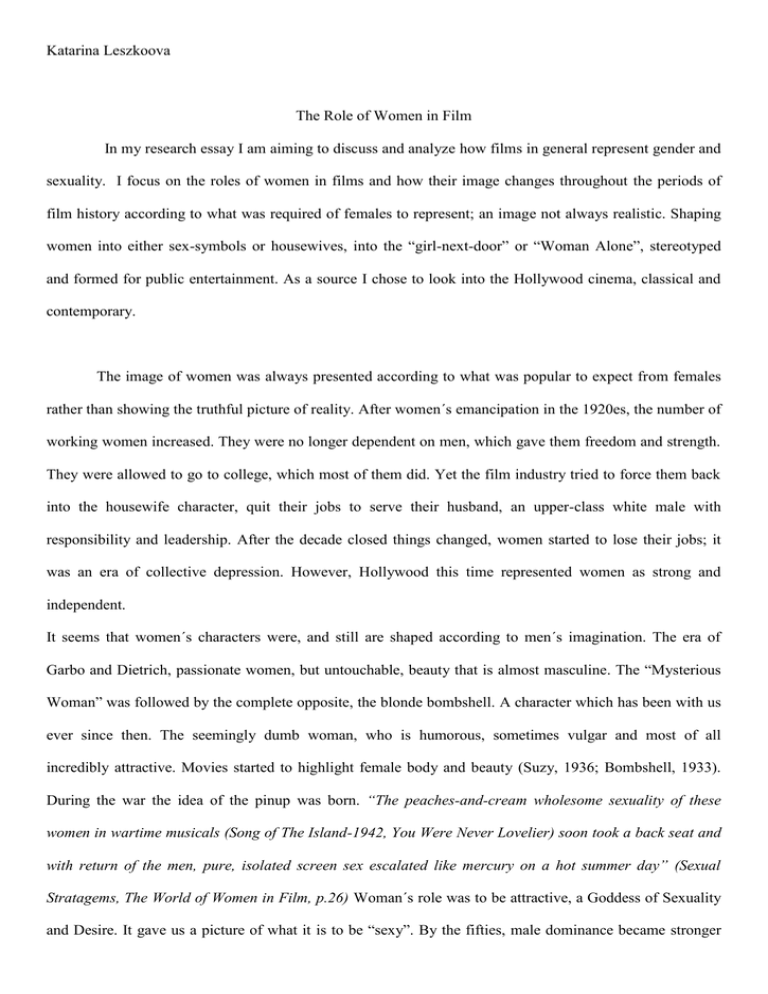
Katarina Leszkoova
The Role of Women in Film
In my research essay I am aiming to discuss and analyze how films in general represent gender and
sexuality. I focus on the roles of women in films and how their image changes throughout the periods of
film history according to what was required of females to represent; an image not always realistic. Shaping
women into either sex-symbols or housewives, into the “girl-next-door” or “Woman Alone”, stereotyped
and formed for public entertainment. As a source I chose to look into the Hollywood cinema, classical and
contemporary.
The image of women was always presented according to what was popular to expect from females
rather than showing the truthful picture of reality. After women´s emancipation in the 1920es, the number of
working women increased. They were no longer dependent on men, which gave them freedom and strength.
They were allowed to go to college, which most of them did. Yet the film industry tried to force them back
into the housewife character, quit their jobs to serve their husband, an upper-class white male with
responsibility and leadership. After the decade closed things changed, women started to lose their jobs; it
was an era of collective depression. However, Hollywood this time represented women as strong and
independent.
It seems that women´s characters were, and still are shaped according to men´s imagination. The era of
Garbo and Dietrich, passionate women, but untouchable, beauty that is almost masculine. The “Mysterious
Woman” was followed by the complete opposite, the blonde bombshell. A character which has been with us
ever since then. The seemingly dumb woman, who is humorous, sometimes vulgar and most of all
incredibly attractive. Movies started to highlight female body and beauty (Suzy, 1936; Bombshell, 1933).
During the war the idea of the pinup was born. “The peaches-and-cream wholesome sexuality of these
women in wartime musicals (Song of The Island-1942, You Were Never Lovelier) soon took a back seat and
with return of the men, pure, isolated screen sex escalated like mercury on a hot summer day” (Sexual
Stratagems, The World of Women in Film, p.26) Woman´s role was to be attractive, a Goddess of Sexuality
and Desire. It gave us a picture of what it is to be “sexy”. By the fifties, male dominance became stronger
and every women´s goal was to marry as quickly as possible, preferably to a rich man (Gentlemen Prefer
Blondes -1953, How to Marry a Millionaire -1953, High Society-1956).
To develop this topic further, I have decided to give an example of the Classical Hollywood Cinema film,
Gentlemen Prefer Blondes (Howard Hawks, 1953). The movie represents two type of women, the wide-eyed
innocent “dumb blonde” Lorelei (Marilyn Monroe) and the witty, charming and independent “brown”
Dorothy (Jane Russell). Both actresses were sex-symbols, and they represent it in the movie as well. The
“dumb blond” in this case though “generally lost her naiveté and took on an increased sophistication; still
the stereotype represents women primarily as sexual objects” (All That Hollywood Allows, Re-reading
Gender in 1950s Melodrama, p.74) so her image became the wiser-than-you-know bombshell. What both
women are searching for is marriage although Lorelei is determined to marry a rich man so her future is
secured. She is smart and knows exactly what she is doing. She acts as the dumb blonde, and her charm
reflects her beauty. Dorothy on the other hand is seeking for love; she is attracted only by good-looking and
fit men. She is smart and witty, the complete opposite of Lorelei. They are both represented as “typical
women”, both of which are either going desperately for a rich man or just for a handsome one. Their biggest
problem is to look good, be beautiful and attractive. They have a craving for clothes and shoes and
significantly for jewellery such as diamonds in this film. Men of course have to fulfil all these criteria’s
usually represented in film and television and they indeed do. We can say that not much has changed since
the 1950s. Women´s roles might change from a sex-symbol back to the housewife although all these
elements are still present in contemporary film-making. A certain image was created about how women
should look like, and what their life should consist of. Their life is called “women´s world”. “This world is
composed of representations that present a set of interests, problems and desires that may sometimes be
incoherent and contradictory but nevertheless construct an identity for the feminine.” (An Introduction To
Television Studies, p. 224) While men have been given various roles and characters to challenge (mostly
though it represents their strength and smartness, a strong picture of masculinity), women are the ones who
need protection. We are weak, not always able to take care of ourselves. Our only purpose is to be attractive,
offer sexual pleasure, be a good housewife, and maybe stupid enough to only care about our little world.
While in the past all these differences were strongly presented by films but nowadays television has a bigger
influence on our lives. While a film can be seen occasionally, the television can be seen daily. Women ´s
issues were transferred into daily and weekly dramas and soap operas, reality shows and family series. A
recent study showed (Gender Oppression in Cinematic Content? A Look at Females On-Screen & Behindthe-Camera in Top-Grossing 2007 Films; Stacy L. Smith, PhD) that “females only occupy 25-28% of all
parts in films and TV programmes”. Also “are more likely than males to be young, thin, and shown in tight
or revealing attire” and “when compared to men, women are more likely to be relational partners and/or
caregivers”. This patriarchal view of the world puts women into perfectly shaped boxes from where it is
hard to escape. A picture that has been with us ever since the beginning of films, showed and consumed so
much that even women themselves believe that their purpose is to be attractive, sexually desirable and to
serve men.
To summarize, my goal with this research essay was to show how the picture of women was
deformed throughout the years of film history and how the false image of women being sexual objects and
men´s satisfaction has been brought to our daily lives, even further in the 21st century. After all the hard
work to gain equal rights for ourselves, we are still represented as the symbol of beauty, saved by the men in
order to serve him. The problem with this is not that we are presented like this, but that qualities other than
these are rarely shown. That the daily life of a woman does not only consist of being beautiful and doing
everything that her man requires from him, that we are not only aimed to please. This false portrait of reality
can only be broken if filmmakers in the future will pay more attention to bring more realistic female
characters on screen. They can be pictured in just as many ways as males, if not more.
Resources:
Sexual Stratagems, The World of Women in Film by Patricia Erens, published in 1979, Horizon Press New
York
All That Hollywood Allows, Re-reading Gender in 1950s Melodrama by Jackie Byars, published in 1991,
The University of North Carolina Press
An Introduction To Television Studies (2nd Edition) by Jonathan Bignell, first published in 2004, Routledge
Internet:
Gender Oppression in Cinematic Content? A Look at Females On-Screen & Behind-the-Camera in TopGrossing 2007 Films; Stacy L. Smith, PhD, Annenberg School for Communication & Journalism
University of Southern California - http://www.seejane.org/downloads/2007Films_GenderReport.pdf








